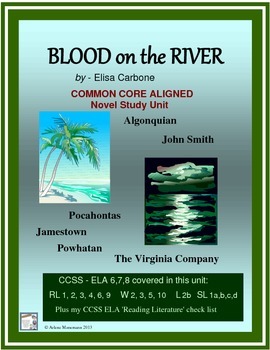BLOOD on the RIVER by Elisa Carbone - Novel Study
- PDF
Description
Reading comprehension questions for every chapter are in this No Prep Novel Study unit for Blood on the River - addressing most Common Core standards - with ANSWER KEY. As students answer questions they are guided through creating good paragraphs by use of introductory and transitional phrases.
Also included WITH ANSWER KEYS are three tests: Ch 1 to 7; Ch 8 - 18; Ch 19 to 27 .
No all-novel test.
Also in the file you will find:
- Puzzles for names in the novel and vocabulary;
- a glossary;
- figurative language lesson with teacher white/smart/or prom. board notes (also usable with document camera), student worksheets and handouts;
- a detailed essay assignment with student handout;
- poetry connection worksheet;
- journal suggestions.
Common Core of State Standards - ELA
in this unit:
RL 1, 2, 3, 4, 6; (with RL check list)
W 2, 3, 5, 10.
L 2b
SL 1a,b,c,d
I include my word search for early finishers: Irregular Plurals
Here are Revolutionary War novel units I sell:
GEORGE WASHINGTON'S SOCKS by Elvira Woodruff
PHOEBE, THE SPY by Judith Griffin
Civil War novel units I sell include:





